Stay in Touch
Subscribe to our newsletter to be informed of the latest product launches.
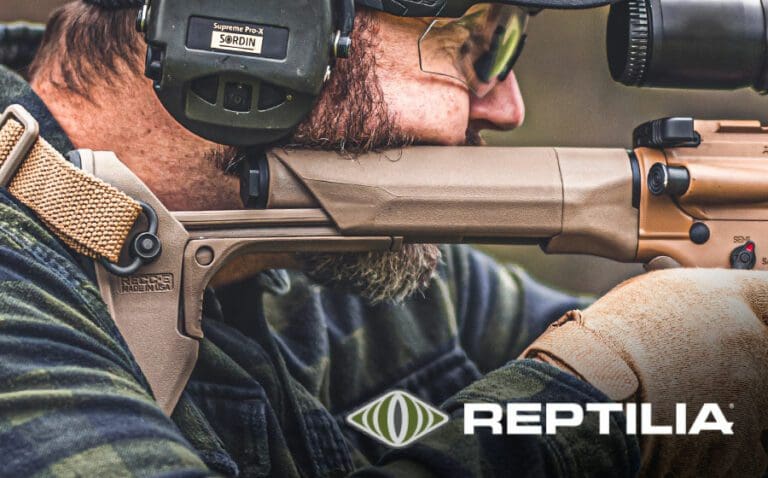
Choosing the right AR15 stock can be overwhelming considering the number of options available. Prices range from under $25 to more than $300, there are modularity and sling attachment considerations, buttpad design, receiver extension and buffer system, the list goes on. So let’s break it down into simple, bite-size chunks that are easy to understand.
Let’s start with some legal considerations and general knowledge, then dive into the different applications you may have for an AR15 rifle. Here we go!
First things first: let’s talk about legality. The National Firearms Act of 1934 defined a number of new firearm categories based on features and function of certain firearms. Generally speaking, among these new classifications were:
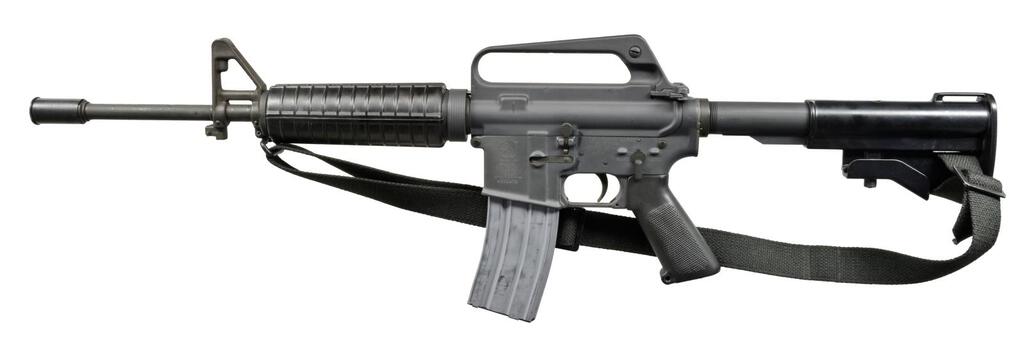
Transferable fully automatic Colt M16 A1 Machinegun. Photo credit: www.proxibid.com
In addition to defining these new categories of firearms, the NFA imposed a $200 per item tax stamp and other bureaucratic hoops that an American citizen would now have to jump through to own an NFA weapon. When adjusted for inflation, that tax is now more than $4,500 in 2023 dollars. This non-refundable tax is paid to the Bureau of Alcohol, Tobacco, and Explosives (BATFE) along with the appropriate form to manufacture or transfer the NFA item:

National Firearms Act (NFA) Tax Stamps. Photo credit: Recoil Magazine
As of February 2023, 44 states allow civilian ownership of SBRs. If you intend to manufacture, transfer, or convert an existing AR15 “pistol” to an SBR, I strongly recommend starting with the Silencer Shop FAQ here.
In simple terms, DO NOT install a stock on any rifle or pistol with a barrel shorter than 16” unless it is a lawfully registered Short Barreled Rifle or Machinegun under the National Firearms Act. Penalty for violating the NFA is up to 10 years in jail and up to $250,000 in fines.
The ATF defines a stock as “…the portion of a firearm that is designed to be held against the shooter’s shoulder and provides support and stability to the firearm while aiming and firing. It typically includes a buttplate or buttstock at the rear, a section for the shooter’s shoulder to rest against, and a forward section or forearm for gripping the firearm.”
Using this definition, for many years some shooters chose to simply not install a stock on their AR15, or use a foam sleeve over the receiver extension as a cheek pad, thereby making it legally classified as a “pistol”. This allowed civilians to purchase AR15 style firearms with barrels shorter than 16”, but did not require registration under the NFA due to their legal classification as a handgun, which does not have the same minimum barrel length regulations as SBRs.
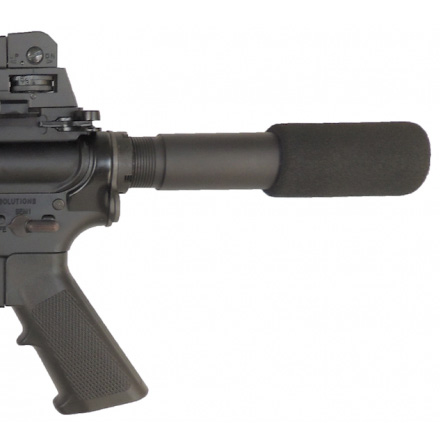
AR15 pistol receiver extension with foam sleeve covering. Photo credit: www.midsouthshooterssupply.com
In 2013, a company called SB Tactical took the AR15 pistol concept even further and introduced a product they call the “stabilizing pistol brace” or “arm brace”, available exclusively through Sig Sauer. This polymer device allowed effective one-handed manipulation of heavy AR15 pistols by strapping and stabilizing the pistol on the shooter’s forearm. These brace products were not designed to be fired from the shoulder, and therefore were approved by the ATF Technology Branch for sale. Note that the ATF initially made a statement that shouldering the brace would constitute the manufacture of an illegal SBR, but then quickly recanted the statement, allowing the user to legally shoulder an AR15 pistol with stabilizing brace.
This new ability to purchase an AR15 pistol with a short barrel that didn’t require an NFA Tax Stamp revolutionized the AR15 market in the United States. Overnight the majority of AR15 firearms sold in America had sub-16” barrels, and were legally used for sporting and defense purposes across the country.
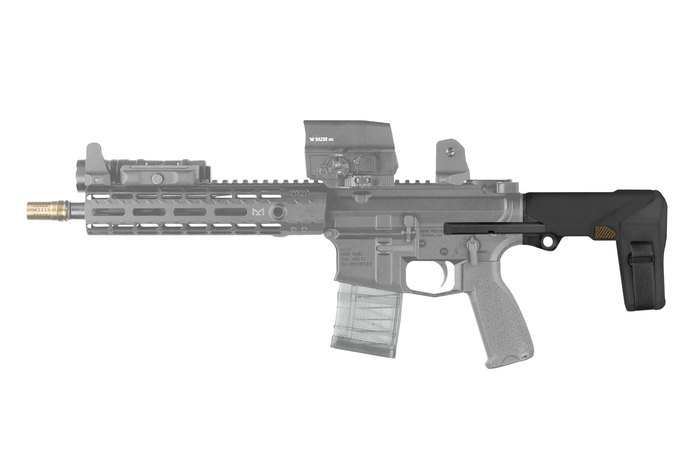
SB Tactical HBPDW™ Pistol Stabilizing Brace®. Photo credit: SB Tactical
On January 13, 2023, the US Attorney General signed ATF final rule 2021R-08F, amending the ATF’s regulations about stabilizing pistol braces, effectively re-classifying every legally purchased AR15 pistol in America as an illegal Short Barreled Rifle under the NFA as of June 1, 2023 unless previously registered.
At the time of publishing this article, there are multiple legal challenges and injunctions issued by Federal Courts. While the legal status of stabilizing pistol braces is still in question, it is not currently advisable to install a brace on any AR15 firearm. If you have an AR15 with pistol brace and are not party to the federal injunctions, the ATF advises you to remove and destroy or surrender the brace or complete firearm.
This part is intended to give you some basic information and terminology of the stock and weapon system.
The receiver extension, also known as the “buffer tube”, contains the action (buffer) spring and buffer. This assembly is collectively known as the “buffer system” and is what allows your AR15 to cycle in a semi-automatic manner, automatically chambering a new round after the pull of each trigger.
The two primary styles of buffer system are rifle and carbine. There are different variations of these systems which we will get into later, but for now let’s start with the basics.
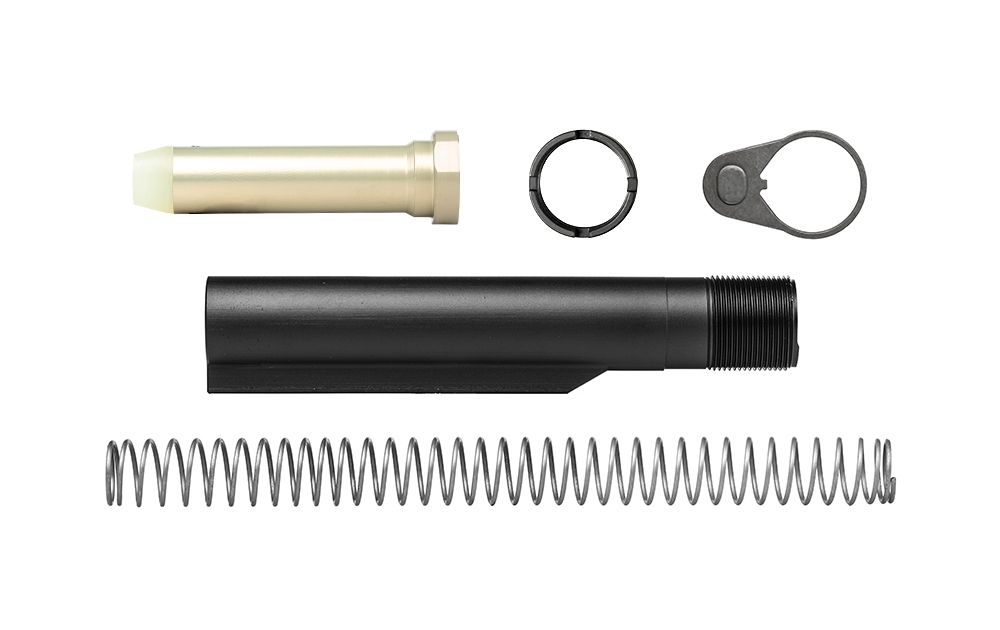
The Carbine Receiver Extension, Carbine Buffer, Carbine Action Spring, Castle Nut, and Lock Plate comprise the most common AR15 buffer system available today. Photo credit: Aero Precision
The rifle buffer system was designed with the original M16 which had a fixed A1-length stock and 20” barrel with rifle-length gas system. This longer, cylindrical buffer system was optimized to minimize recoil and keep the cyclic rate of fire down to a controllable speed, around 600 rounds per minute.
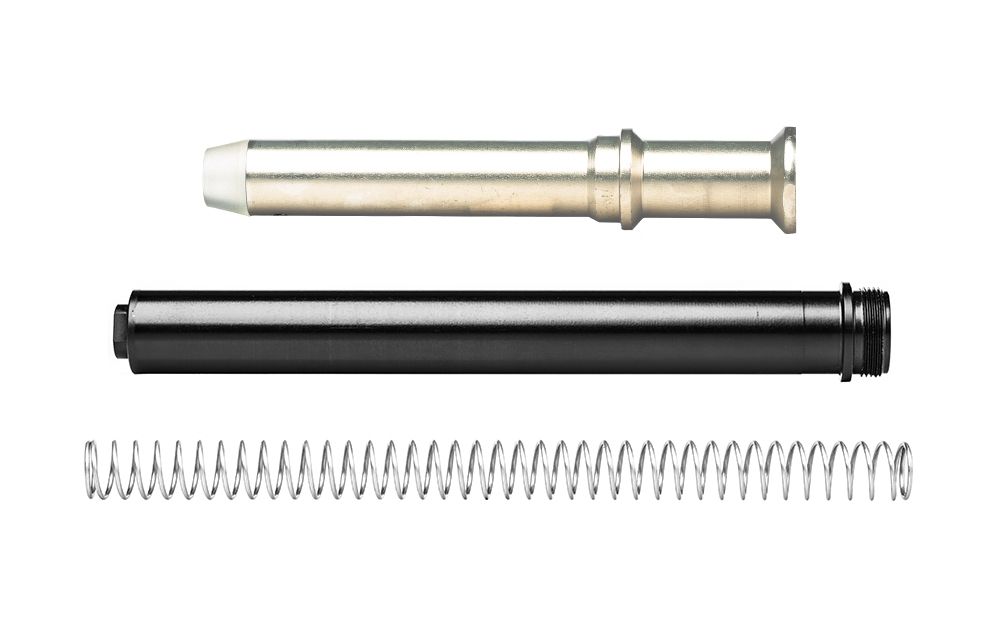
The Rifle Receiver Extension, Rifle Buffer, and Rifle-Length Action Spring used on A1 and A2 M16/AR15 style weapons.
As soldiers began wearing more equipment and smaller, often female warfighters entered the service in larger numbers, it became apparent that a fixed M16 rifle stock was too long for effective use and a shorter, adjustable replacement should be selected.
The Vietnam war sparked a flurry of innovation in the realm of compact and subcompact weapons due to the nature of jungle and close quarters combat. Both the barrel length and buffer systems were shortened to create a more compact weapon for easier maneuverability in confined spaces. Several shortened receiver extension designs were tried, but the most widely adopted features a keyway on the bottom with holes for simple length of pull adjustment. The CAR15 and its variants were born.
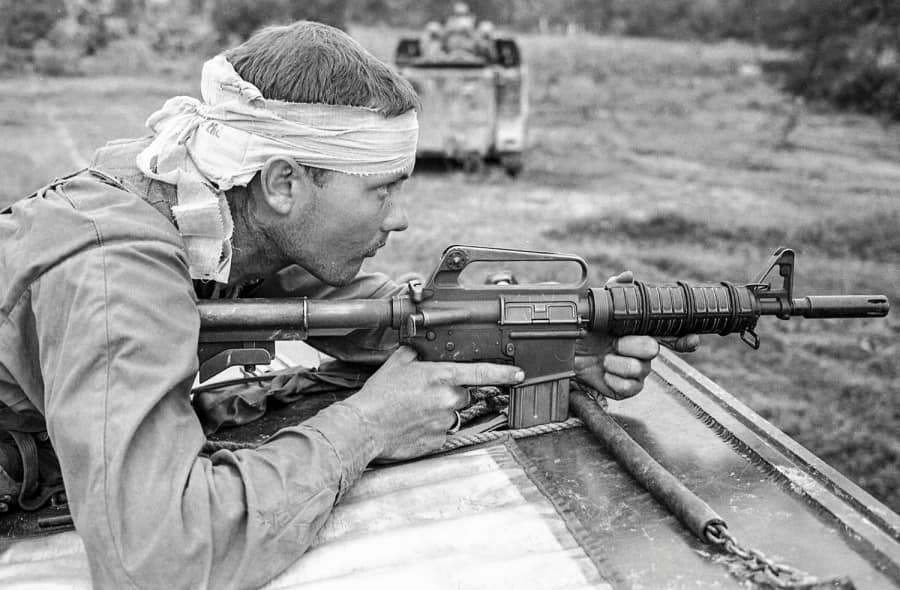
Colt XM177 Carbine. Photo credit: www.thecoltar15resource.com
While not as popular as collapsible stocks, there are a couple applications for which rifle-length stocks excel: long range precision and historical clone building.
The dramatic increase in popularity of large-frame .308 and 6.5 Creedmoor AR platforms has driven a spike in development of precision-oriented AR stocks. While generally heavier than collapsible stocks, these products offer a wide range of precise adjustability, generally through dials, spacers, or risers. The Magpul PRS, for example, is very popular among both civilian precision shooters, law enforcement marksmen, and military snipers.
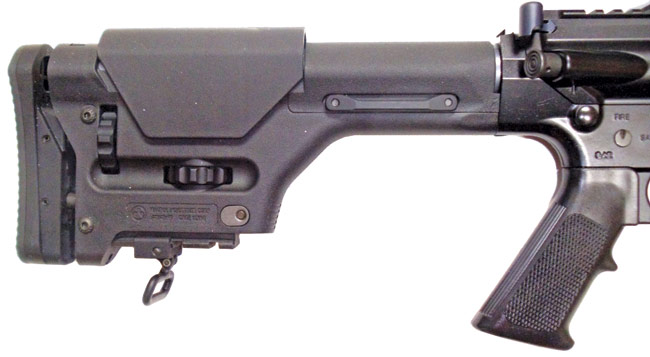
Magpul PRS Stock on Armalite Super SASS .308 AR10 rifle. Photo credit: Small Arms Defense Journal
With the expiration of the Clinton Assault Weapons Ban in 2004, the civilian market exploded with the newfound ability to use collapsible stocks and other once-prohibited accessories. In a market where the only option was a cheap, standard M4 stock suddenly appeared companies like Magpul, VLTOR, LMT, ACE, and more. The commercial viability of these products finally made innovation in the AR15 market possible. Let’s dive into some of the features and considerations you’ll have to address in choosing your perfect stock.
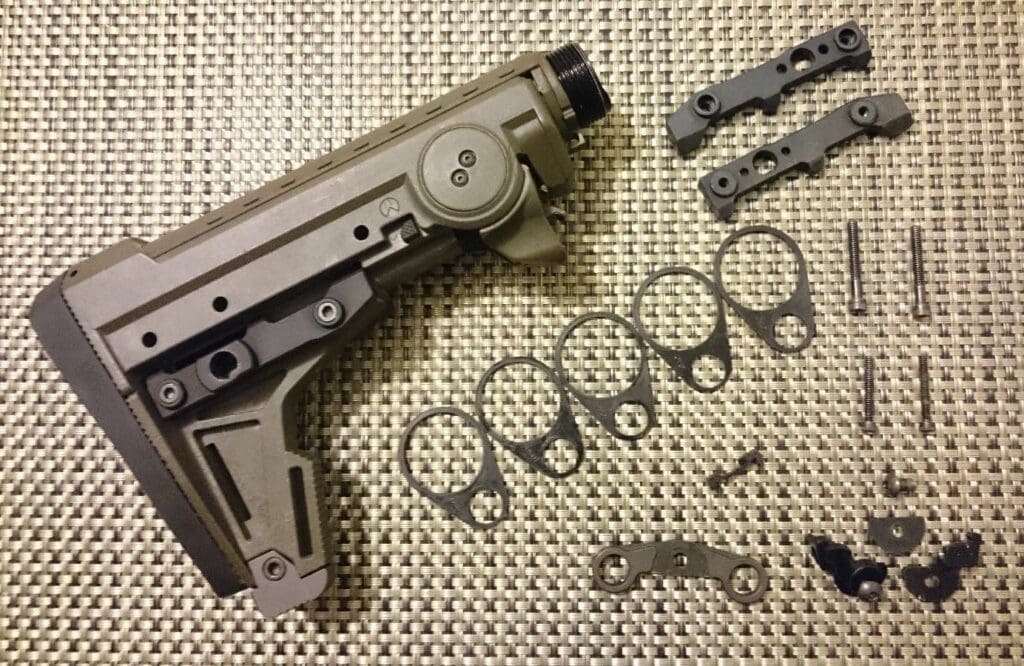
Magpul M93B collapsible AR15 stock. The M93B was one of the first truly unique collapsible stocks brought to market after the expiration of the 1994 Assault Weapons Ban.
The elephant in the room. AR15 stocks can cost as little as $20 or more than $300 depending on the brand, feature set, and quality. If you’re worried about spending hundreds of dollars on a premium product, don’t sweat it, there are plenty of great U.S.-made options for $60 to $160. Plus, that’s the beauty of the AR15: you can always upgrade later as your taste and budget evolves.
If you already have an AR15 with carbine receiver extension, it does not require any tools whatsoever to remove your existing stock and drop a new one on. If you are unfamiliar with the AR15 platform or do not have the specialized tools to perform armorer-level tasks, this is by far the simplest way to upgrade your rifle.
If your AR15 stock requires removal and re-installation of a carbine receiver extension, lock plate, and castle nut, consult your armorer’s manual or qualified gunsmith for assistance. Note: make sure to identify whether your rifle has a “commercial” or “milspec” carbine receiver extension before purchasing a stock. This guide is useful.
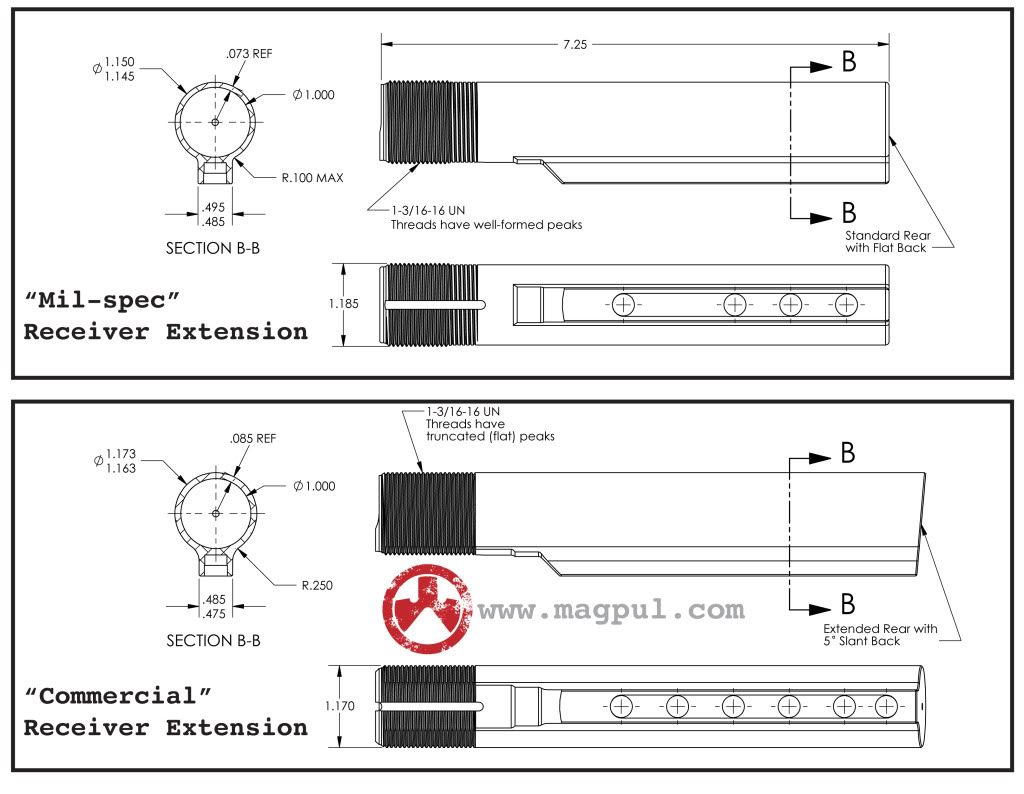
MILSPEC vs. Commercial Receiver Extension comparison. Photo credit: Magpul
One benefit to round rifle-length and proprietary receiver extensions found in stocks like the Magpul UBR and Reptilia RECC•E™ Stock is they do not require timing of the receiver extension or use of a lock plate or castle nut. This minimizes the number of tools required for installation. Check our our RECC•E installation video for a detailed walkthrough of the process.
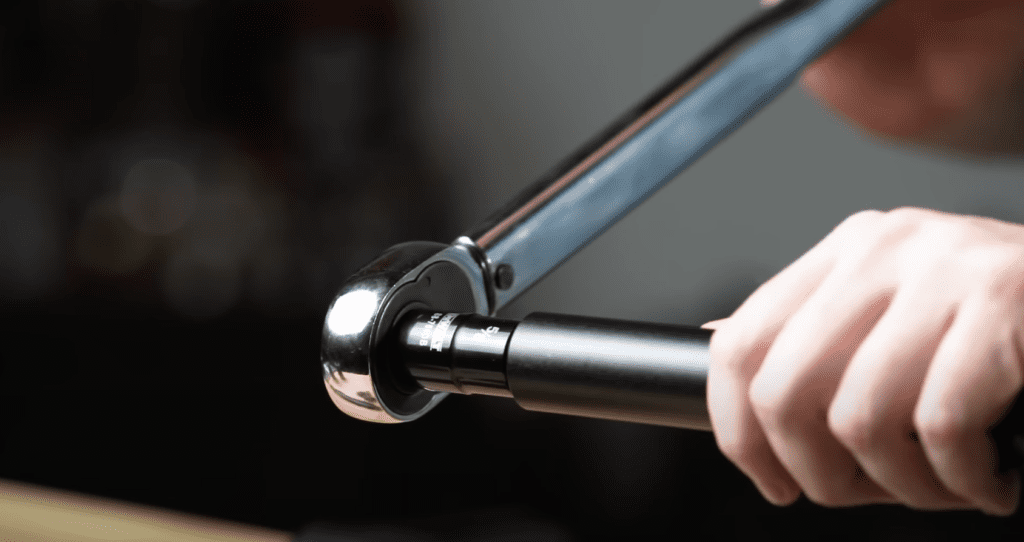
The Reptilia RECC•E installs with a simple torque wrench, no castle nut, lock plate, or timing required. Photo credit: Reptilia Corp.
The founder of Magpul, Richard Fitzpatrick, believed that every rifle, no matter what, should have the ability to attach a sling. At Reptilia, we happen to agree. The two main considerations for sling use are attachment type and location.
Today, one of the most common types of sling attachments is push-button quick detach, or “QD” for short. QD slings gained popularity post-9/11 when soldiers needed the ability to quickly remove equipment to exit vehicles that have been crashed or attacked. A simple push of the top button (or pull of a cable with some designs), and your sling falls freely from the weapon.
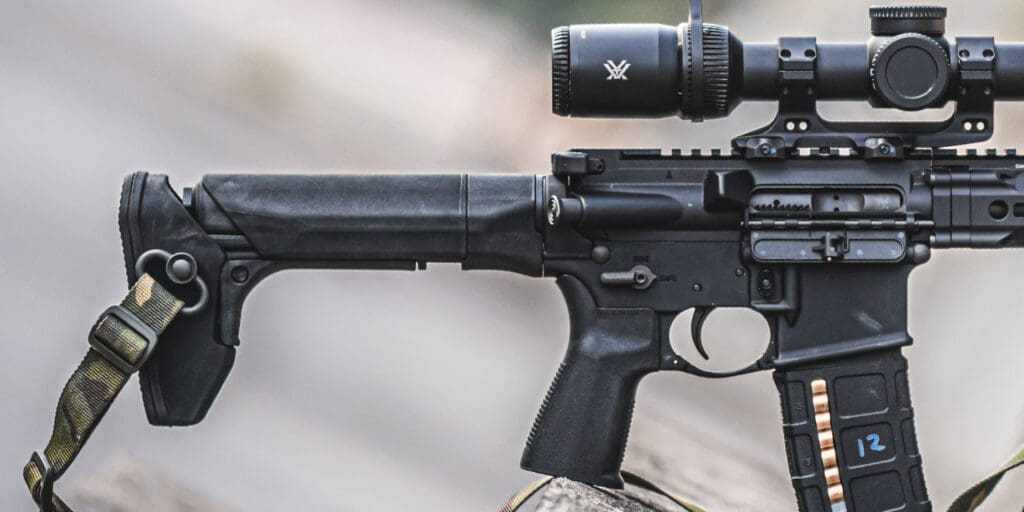
Push-button QD sling attachment point on the rear of the Reptilia RECC•E Carbine Stock. Photo credit: Reptilia Corp.
While not as convenient as push-button QD, a loop or other clip-in style attachment is sometimes mandated for weapon retention, particularly for military and law enforcement who operate on or above water or in aerial platforms.
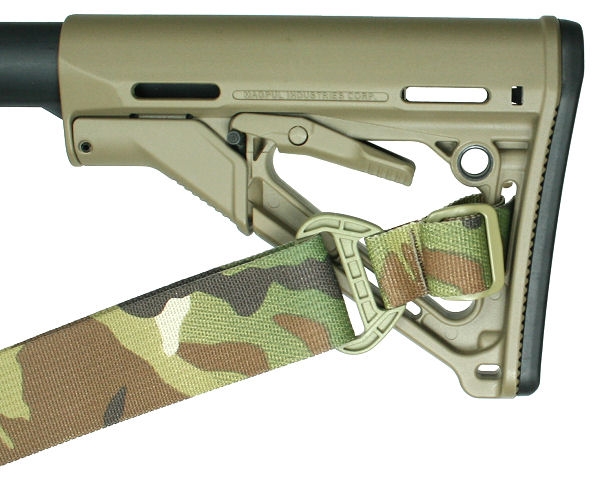
Specter Gear sling with Magpul CTR Stock. Photo credit: Specter Gear
The location of sling attachment points is user preference, but commonly found at the upper rear portion of the stock, just in front of the rubber buttpad, near the front of the stock body near the receiver, or on the carbine lock plate itself. There are benefits and drawbacks to every location, and it is recommended you seek formal training to determine the best sling configuration for your application.
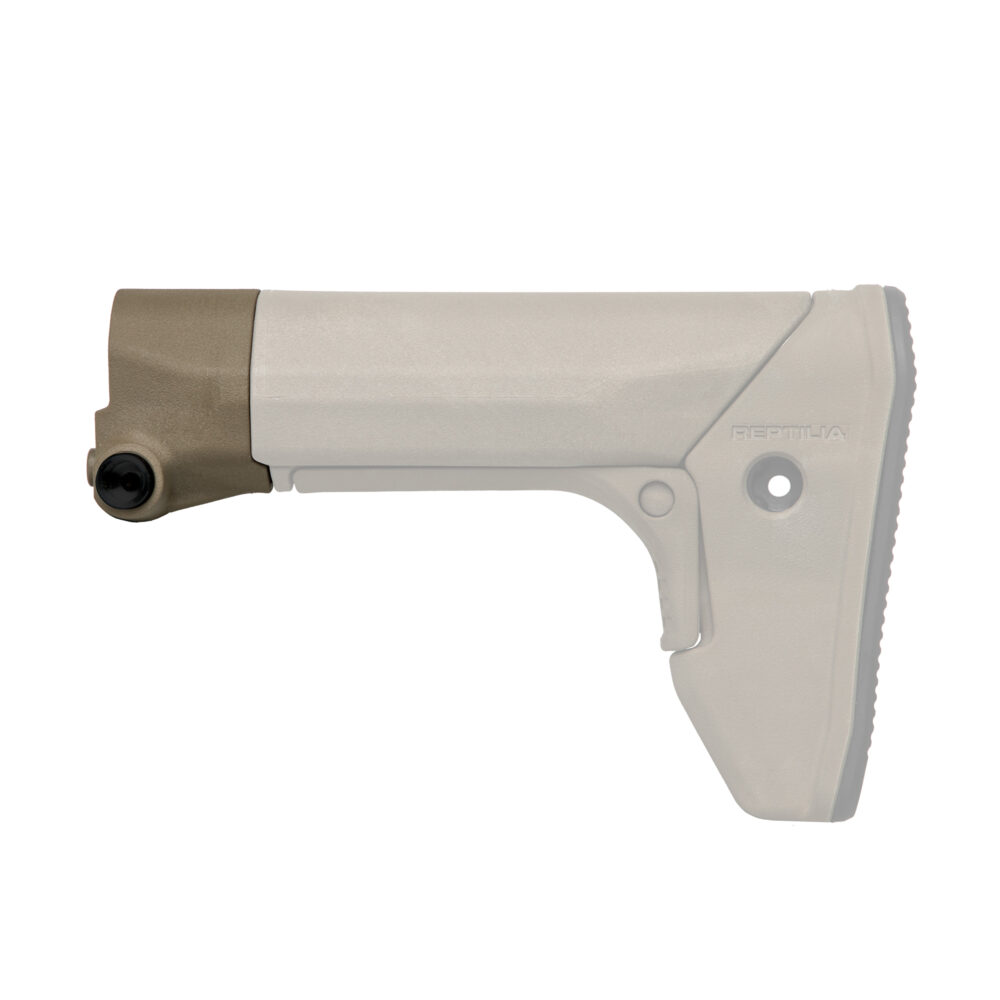
Reptilia RECC·E Carbine Stock QD Front End. Photo credit: Reptilia Corp.
Recent years have seen an initiative to minimize weight wherever possible on the weapon, mainly driven by the increasing number of accessories, optics, and electronics being added to rifles. Be honest with yourself about what you are doing with the weapon and what you truly need. If this is a benchrest gun that will be carried from the car to the firing line, extra weight will help mitigate recoil and facilitate faster follow-up shots. If this gun will be carried on patrol or on hunting trips, additional weight should be avoided when possible.
For reference, a basic CAR-15 collapsible stock weighs roughly 4.2 oz., whereas a Magpul PRS Gen 3 weighs 28 oz, or roughly 1.5 pounds more. The difference between the lightest and heaviest is meaningful and should be taken into consideration.
The primary advantage of a collapsible AR15 stock is the ability to adjust length of pull (LOP) to accommodate different clothing, equipment, or shooter body sizes. The ability to fit the gun to yourself while wearing a t-shirt, body armor, or allowing your smaller stature family members makes the platform extremely versatile. Additionally, this capability helps with transport of the firearms and concealability for tactical applications.
Stocks like the Magpul PRS allow for precision LOP adjustment in very fine precision increments up to 1.4” in length. The most common adjustable stock utilizes a carbine receiver extension with 4, 5, or 6-positions spaced evenly over 3.0” – 3.5” of adjustment range. This method is less precise, but much faster and far more economical to produce.
For a more detailed explanation of LOP, visit our friends at The Firearm Blog.
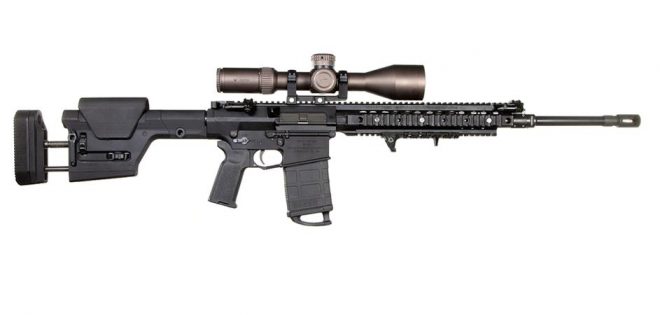
Magpul PRS Stock at maximum length of pull setting. Photo credit: The Firearm Blog
The cheek weld is critical to shooter comfort, not just in terms of shape, but also the stock’s tendency to grab and rip beard hair. Like everything, there is no free lunch: the more comfortable a cheek weld is, the larger and heavier it tends to be. So again, ask yourself this: what purpose does this rifle fill? The most common types of cheek weld you will encounter are precision, carbine, and subcompact.
The best examples of this are found on the Magpul PRS and B5 Systems Precision Stock. These stocks feature vertically adjustable cheek pieces to better position a shooter’s head behind a magnified scope. These stocks utilize dial mechanisms for very fine adjustments required for long range precision shooting and sniper applications.
Precision stocks are generally used on guns with 16”-22” barrels, often chambered in long range calibers such as 6.5 Grendel, 6mm ARC, .308 Winchester, 6.5 Creedmoor, or others.
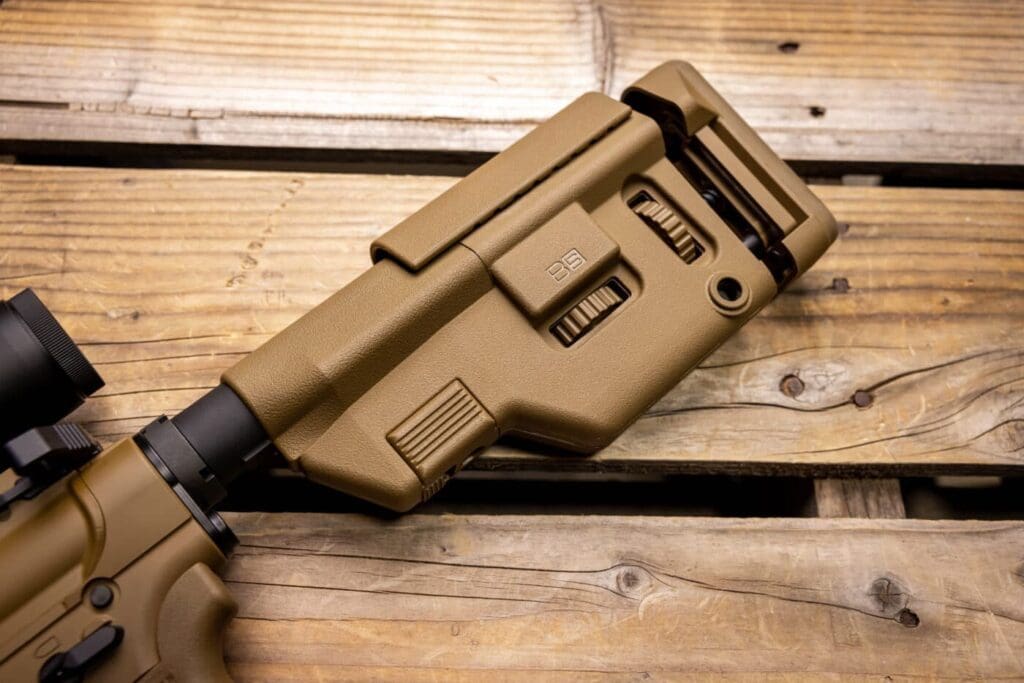
B5 Systems Precision Stock. Photo credit: The Armory Life
Part of the United States Special Operations Command (USSOCOM) Special Operations Peculiar Modification (SOPMOD) weapons accessory program was an AR15 stock with angled cheek weld that became known as the “SOPMOD Stock”. Produced by Lewis Machine & Tool (LMT), the SOPMOD Stock paved the way for other sloping cheek weld designs such as the VLTOR EMOD/IMOD and Magpul ACS/STR.
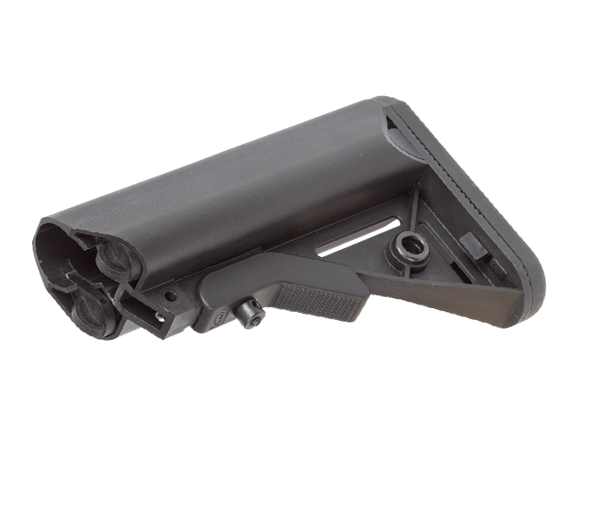
LMT SOPMOD Buttstock with sloping cheek weld. Photo credit: Lewis Machine & Tool
While the sloping cheek weld can be more comfortable, one thing many shooters don’t consider at first is their beard. A common complaint about the VLTOR stocks is beard hair catching uncomfortably in the cheek weld area.
This is the most common design: a basic M4 minimal cheek weld. Nothing fancy, you probably already own a Magpul MOE Stock or basic CAR-15 stock. These stocks are generally slimmer in profile, lighter weight, and less expensive. These are highly recommended for basic hobby, defense, or duty builds: everything you need, nothin you don’t.
This niche category has become very popular over the past 10 years, primarily driven by the advent of rifle-caliber subcompact weapons like the Q Honey Badger, Maxim Defense PDW, and SIG MCX. This category requires historical context before talking about the sub-compact rifle stock options.
Military special operations and law enforcement SWAT have always had a need for subcompact weapons that operate efficiently in close quarters. Traditionally, this role has fell on pistol caliber submachineguns such as the Thompson, Sten, Grease Gun, HK MP5, IMI Uzi, and more modern platforms such as the HK MP7, HK UMP, B&T APC, and 9mm AR15 variants. These were chambered in pistol calibers such as .380, 9mm, .40, .45, and 10mm, and featured a fully automatic rate of fire, short barrel, and often a silencer for use in buildings and on ships.
When America went to war after 9/11 we quickly realized that pistol caliber submachineguns were severely lacking in accuracy, range, and overall lethality for the mountains of Afghanistan and the streets of Iraq. Simply put, the MP5-SD at best was shooting dinner plate-size groups at 100 yards, and enemies would “dance around like they were getting stung by bees” when shot with the anemic subsonic 9mm bullet. Special operations needed a quiet, compact weapon that actually killed bad guys. Enter the 300 AAC Blackout (300 BLK).
In the early 1990’s JD Jones of SSK Industries was ahead of the trend and invented a cartridge called “300 Whisper”. For all intents and purposes, 300 Whisper is a 5.56×45 NATO case necked up and cut down to 7.62×35 and optimized to shoot heavy, accurate subsonic 30-caliber bullets from short barrels. Unlike the 9mm MP5-SD, which fired 115-147gr bullets with poor accuracy and even worse terminal ballistics, the 300 Whisper fired .308 rifle bullets accurately and with far superior wounding characteristics.
In 2009, Advanced Armament Company (AAC) was approached by a special operations customer seeking to replace their aging fleet of HK MP5-SD weapons with a new platform and caliber that was lighter, more accurate, more ergonomic, and had superior terminal effects on man-size targets. AAC standardized this .30-caliber cartridge with the Sporting Arms and Ammunition Manufacturers’ Institute (SAAMI) as the “300 AAC Blackout” or “300 BLK” for short, and started mass producing ammunition at the Remington and Barnes ammunition plants.
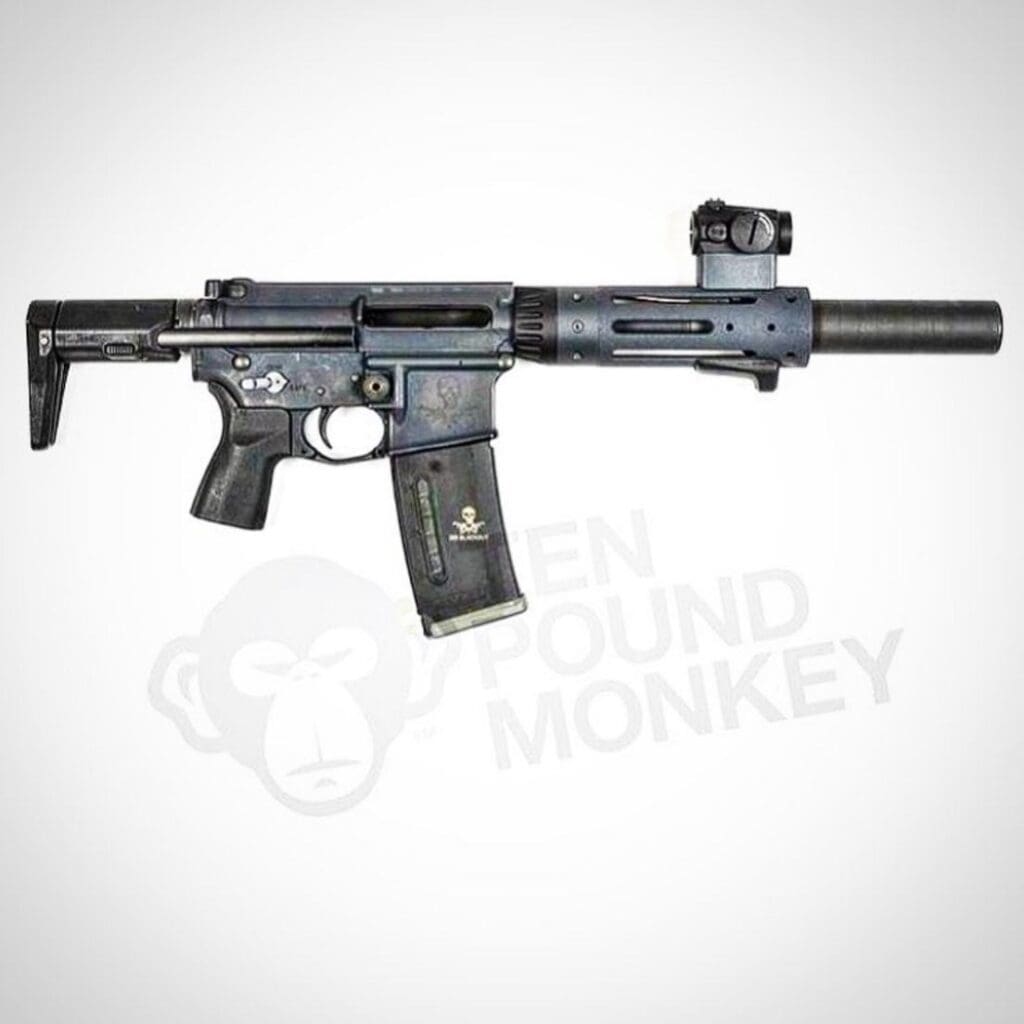
Prototype Advanced Armament Corp. Honey Badger compact weapon. Photo credit: Ten Pound Monkey
The 300 BLK cartridge reenergized an entire category of firearm: subcompact assault rifles. These new weapons were not only lighter and more ergonomic than the previous generation of pistol caliber submachineguns, they were far more accurate and lethal. Companies like Q, SIG, Maxim Defense, LMT, and others developed shortened barrels and buffer systems to further miniaturize the platforms. For the first time it was possible to put the firepower of a full size rifle into a backpack. Make no mistake: these weapons were made for efficiency and concealability, not comfort or precision.
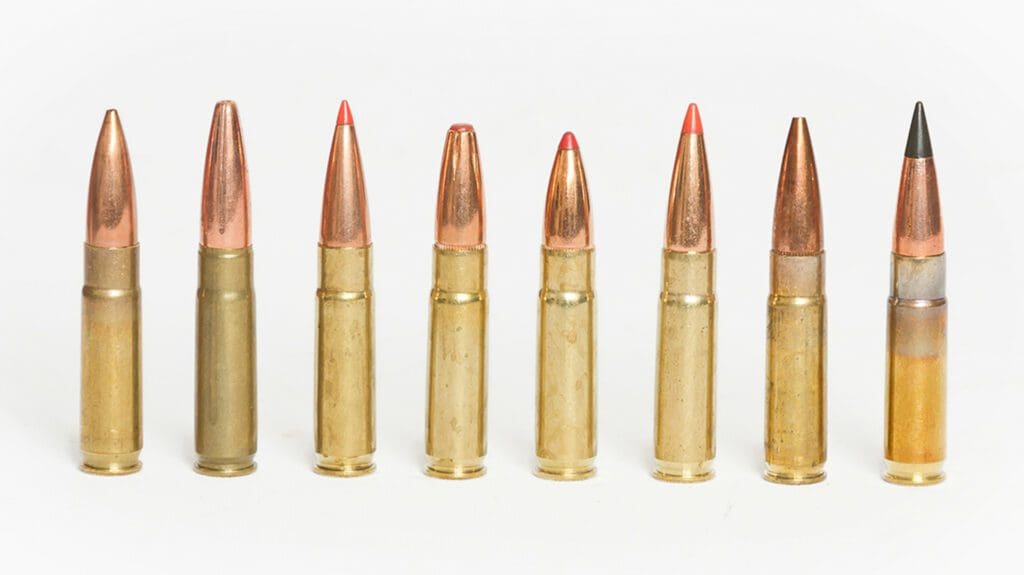
300 BLK ammunition comparison. Photo credit: 80 Percent Arms
From this renaissance came a new crop of subcompact AR15 stocks with proprietary buffer systems. Note: there is no standardization on subcompact stocks, and every one has been tuned for a complete weapon system. Each of these systems has their own proprietary receiver extension, action spring, and buffer that may or may not function reliably with your AR15. For that reason, it is not advisable for new AR15 owners to experiment with subcompact stocks unless purchased as part of a complete firearm.
Most AR15 firearms currently in production will come with a carbine receiver extension, carbine action spring, and carbine buffer, but there are actually a range of buffer options on the market to fine tune your rifle for the best reliability and lowest recoil.
Within the standard carbine buffer design the commonly available options only differ based upon weight. Each carbine buffer has 3 independent moving weights inside, each made of a specific material depending on the weight desired. These weights are free floating and act as a “dead blow” hammer for the recoil system, with heavier weights being chosen for weapons with higher cyclic rates and larger gas ports.
The commonly available carbine buffer types are carbine, H, HH, H2, H3, and the US Army’s H6 developed by Picatinny Arsenal, designed to optimize reliability of a carbine buffer system on a full-size 20” M16 rifle. As a rule of thumb, most AR15 weapons will function reliably with an H buffer, but shooters may choose to increase the weight to H2 or heavier on short barreled rifles and rifles with silencers.
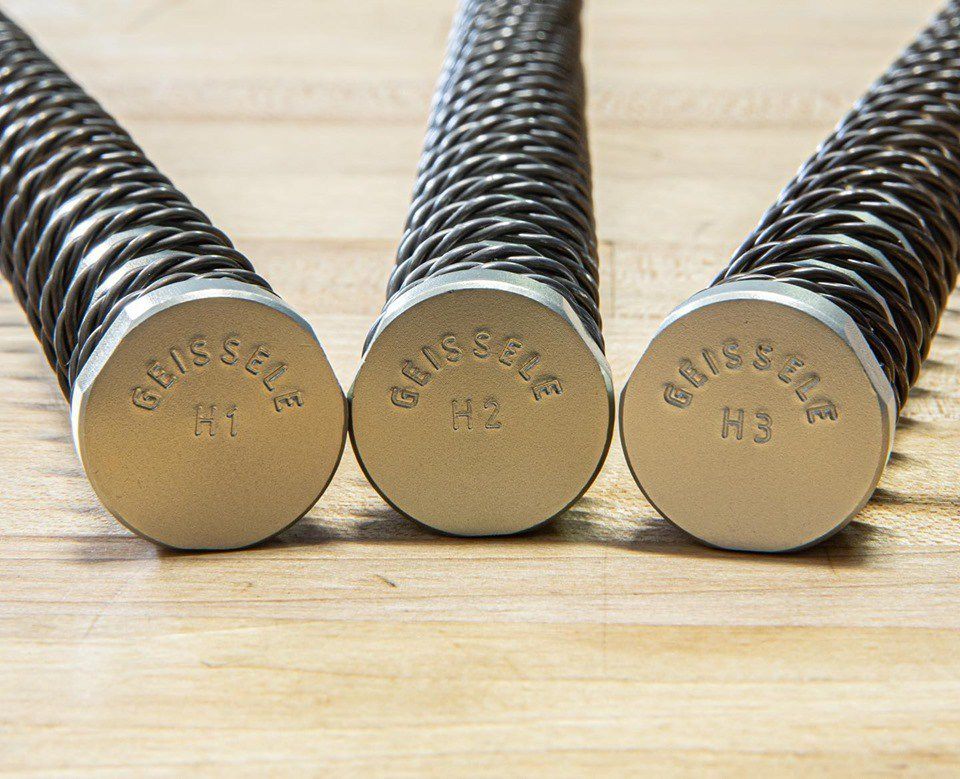
H1, H2, and H3 carbine buffers. Photo credit: Geissele Automatics
In the late-2000’s, the US Marine Corps identified a need to equip their M16A2 and M16A4 rifles with collapsible stocks to better fit smaller stature Marines. After fielding the Trijicon ACOG 4x optic it became very clear that a proper eye relief was almost impossible to obtain for many warfighters. They began evaluating M16 reliability with the US Army’s Picatinny Arsenal while VLTOR Weapon Systems independently developed the A5 buffer system. This A5 design was roughly ¾” longer than a standard carbine buffer system, which reduced cyclic rate and bolt bounce while maintaining weapon reliability.
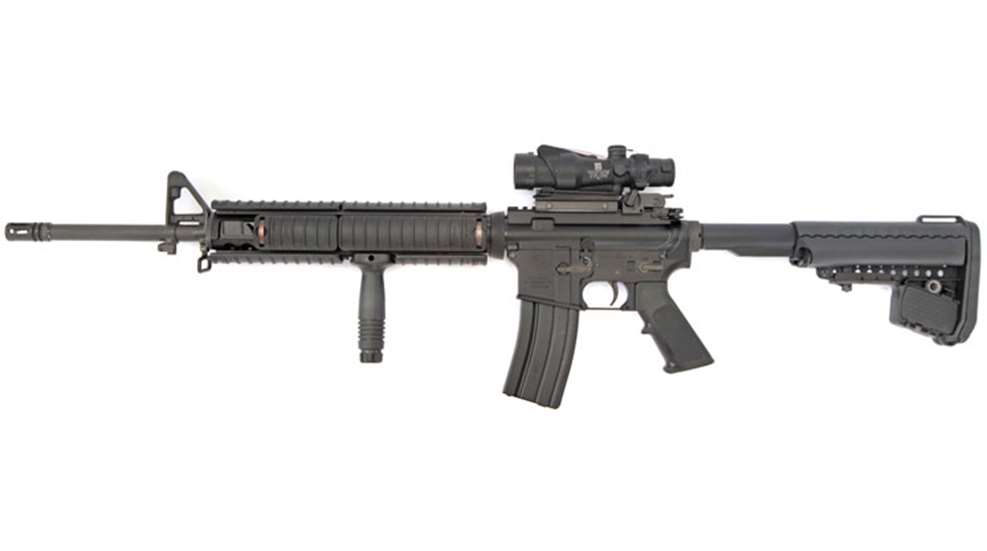
M16 rifle with VLTOR A5 buffer system. Photo credit: American Rifleman
Due to the popularity of this system, many AR15 stock manufacturers, including Reptilia, have made accommodations in stock designs to ensure A5 compatibility. For example, the Reptilia RECC·E™ Carbine Stock has a modular front portion that allows for use of standard carbine, VLTOR A5, or Knight’s Armament Company SR25 buffer systems by swapping the receiver extension and forward section of the stock body.
Generally speaking, the AR platform can be broken down into four primary use cases, each of which has some level of capability and use case overlap:
These are the least comfortable, but most compact and lightest AR15 stock options available. These stocks utilize proprietary buffer systems and are generally engineered for use on extremely short barrel carbines, generally under 10.5” barrel length. Some good options for your sub-compact AR build are:
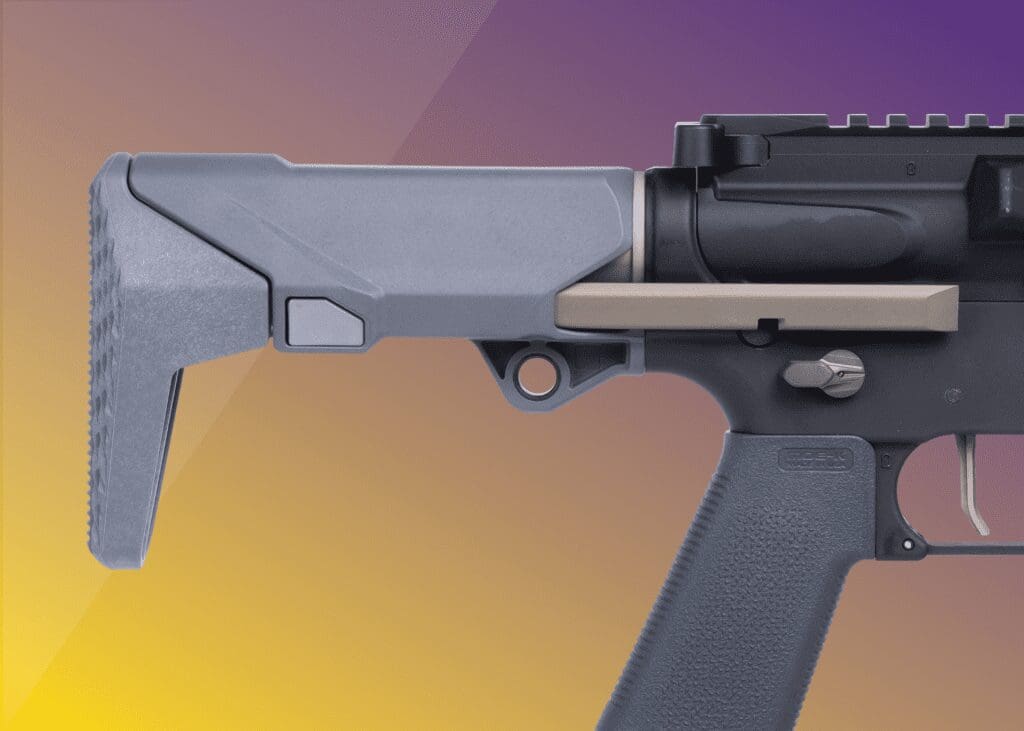
Shorty Stock by Q. Photo credit: Q, LLC
The general purpose carbine is a blend of performance and practicality. The gun should be capable of taking accurate shots at intermediate distances, but also useful in close range engagements. For this task, barrel lengths generally range from 11.5” to 14.5” in length. This means compromises must be made in terms of comfort, weight, and features, but not to the same degree as a subcompact stock. Some good options for your carbine AR build are:
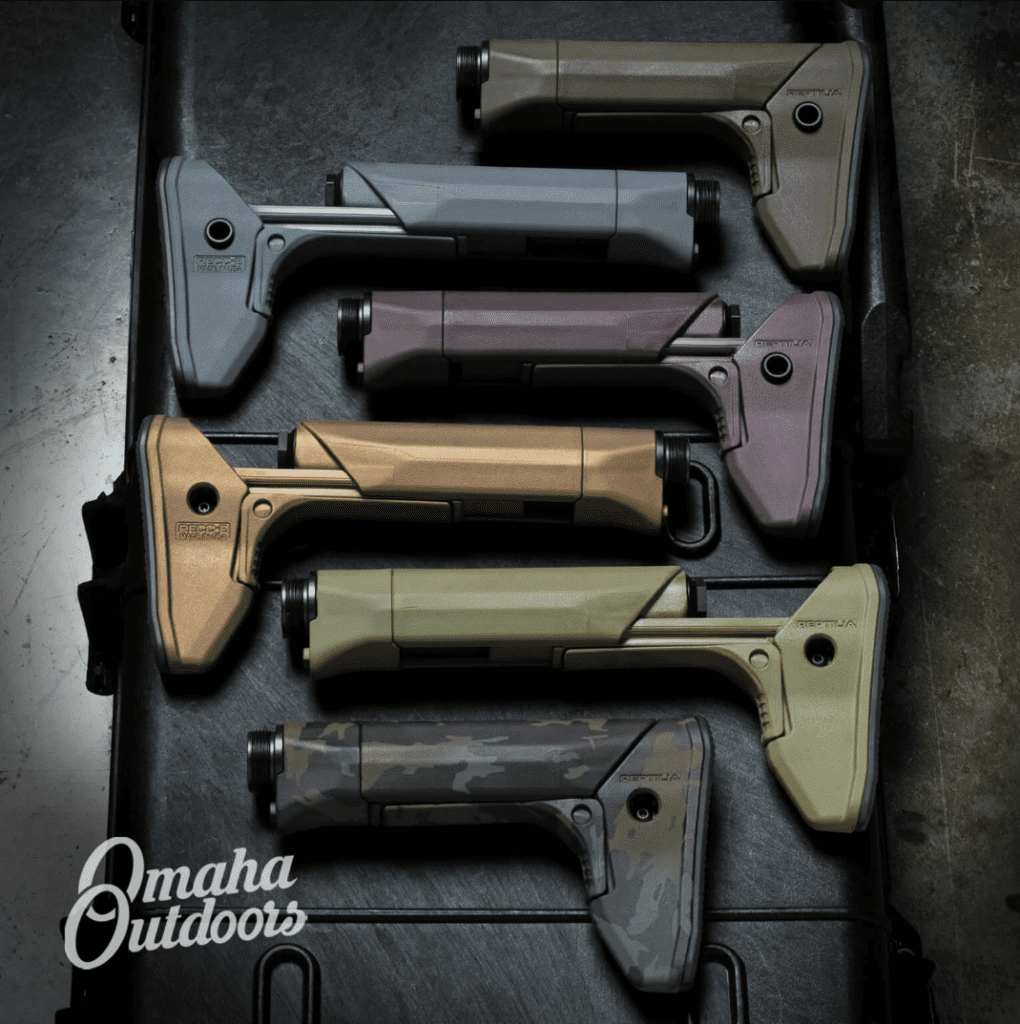
SPR/RECCE configurations shine at intermediate distances from 100 to 800 yards depending on cartridge selection. Comfort and precision are a higher priority than weight, and often times longer buffer systems are utilized such as the VLTOR® A5 or full-size A2 rifle-length buffer for recoil mitigation and reduction in weapon cyclic rate. Barrels on SPR/RECCE weapons are generally 14.5” to 18” in length, and sometimes utilize niche cartridges such as the 6.5 Grendel or 6 ARC. Some good options for your SPR/RECCE AR build are:
Reptilia RECC·E Carbine Stock, custom colors by Omaha Outdoors. Photo credit: Omaha Outdoors
The last 10 years have seen an explosion in popularity of long-range AR platforms such as the Knight’s Armament SR25, Seekins SP10, LMT MWS, and others. These weapons generally have barrels between 16” and 22” in length depending on caliber and application, and often use extended buffer systems such as the KAC SR25 Carbine Buffer or full-length A2 Rifle Buffer. Long range precision out to 1000 yards is the main objective, so these weapons are often heavier and larger than the previously mentioned configurations, and chambered in calibers such as .308 Winchester, 6.5 Creedmoor, or .260 Remington. Some stocks offer a range of precision length of pull (LOP) and cheek piece height adjustments for further customization to each shooter. Some good options for your precision AR build are:

LMT MWS with LMT Precision Stock. Photo credit: Lewis Machine & Tool
This may seem like a lot to take in for new shooters, but it’s pretty simple once you decide for what purpose your rifle will be used. Try not to force one gun into multiple roles if you can avoid it, but the Carbine and SPR/RECCE configurations tend to be the most useful across a broad spectrum of applications. If you have any questions at all, shoot us an email at [email protected] or drop a comment on our Instagram or Facebook!
Subscribe to our newsletter to be informed of the latest product launches.